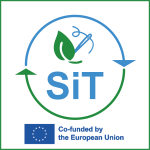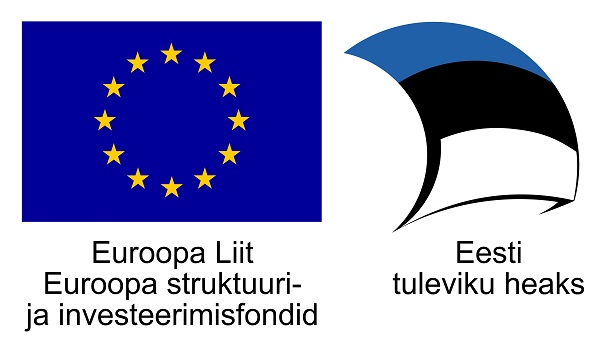“SiT – Sustainability in Textile”
The project “SiT – Sustainability in Textile” intends to respond to the current societal and economic challenges by:
- a) analysing the emerging occupations and skills gaps for the green transformation of the TCLF sector
- b) developing specific training modules focusing on the green competencies for different educational levels (HE, c-VET from EQF5 to EQF6)
- c) promoting a bottom-up approach in skills development, involving TCLF SMEs and organisations representing enterprises and the TCLF sector.
The project “SiT – Sustainability in TCLF” will respond to the objectives of Lot 1- Alliances for education and enterprises, by fostering innovation in higher education (HE) and Vocational Education and Training (VET) by:
- a) creating a bridge between education and training and the labour market
- b) analysing emerging occupations and new skills in the TCLF sector and
- c) developing a “green” mindset in students/learners and TCLF professionals.
The innovation brought by the project, through the introduction of green principles, sustainability and circular economy approaches, will also contribute to fostering TCLF survival, growth, and sustainability, through upskilled and enhanced owners and staff skills.
The overall SiT structure can be summarised as follows:
Step 1 the focus will be on establishing local/national knowledge triangles (KT) and conducting a training needs analysis to identify and map two new emerging occupations in the textile sector. The project will involve surveying and interviewing various stakeholders, including textile SME owners and professionals, using a mix of methodologies and tools. The goal is to co-create
knowledge and take a learner-centred approach. The analysis will be used for the identification and mapping of 2 new emerging occupations to boost the green transformation of the textile sector.
Step 2 will consist of the development of the training curricula, modules, material and methodologies which will be designed not only by partners but will be strongly informed by input from knowledge triangles representatives and evaluated by experts through design thinking methodology. A selection of specific training modules will lead to complete training for the 2 occupations identified.
Step 3 will consist of the development and update of a MOOC platform addressed to HE and VET learners, which will be open to students and professionals but will also be crucial for the delivery of the training courses foreseen. FPE will work on the design and development of the MOOC platform, which will host the online part of the blended training for VET and HE learners.
Step 4 will consist of the training pilot action, during which the newly-developed curricula will be tested and delivered through 3 different phases: 1) MOOC (open, online training); 2) Blended training, including Face2Face training and project-based learning (based on the development of green solutions for the textile sector and an international boot camp); 3) Work-based learning (for both HE and VET learners).
Step 5 focuses on the establishment of local green TCLF ecosystems and local hubs to promote the integration of green principles into local economies. The first activity of this step is the development and signing of a Memorandum of Understanding for local development through green transformation of the TCLF sector in each country. Focus groups will be organised to guide
stakeholders in understanding and analysing the SiT actions. An interactive platform will be created to support the creation of local multi-actor networks, share best practices and support the process of green textile business start-up. The platform will also promote SiT education approach by involving textile SME owners and professionals in the experimentation and future editions of the training course. Local Hubs will be promoted to provide support for the green transformation of the TCLF sector.
Step 6 A combination of communication and dissemination activities will support the overall SiT implementation.
Project partners
The project involves 15 partners from 8 EU countries, the consortium is made up of organisations from VET, c-VET, HE and business representatives in order to create a bridge between education and labour market.
- ITALIENISCHE HANDELSKAMMER FÜR DEUTSCHLAND (DE) Coordinator
- VDMD NETZWERK FÜR MODE TEXTIL INTERIEUR ACCESSOIRE DESIGNER INNEN EV (DE)
- CAMARA DE COMERCIO ITALIANA – BARCELONA (ES)
- ICEP s.r.o. (SK)
- ASOCIACIÓN DE CENTROS DE FORMACION PROFESIONAL FP EMPRESA (ES)
- PLOVDIV CHAMBER OF COMMERCE AND INDUSTRY (BG)
- APOSTOLINA TSALTAMPASI KAI SIA EE – OECON GROUP (EL)
- AKMIAE AKMI EDUCATIONAL ORGANISATIONS (EL)
- PIRIN-TEX EOOD (BG)
- LOOV EESTI (EE)
- EESTI KUNSTIAKADEEMIA – EKA (EE)
- VELEUČILIŠTE U ŠIBENIKU (HR)
- ISTITUTO REGIONALE PER L’EDUCAZIONE E GLI STUDI COOPERATIVI IRECOOP VENETO (IT)
- NEVROKOPSKA PROFESIONALNA GIMNAZIA “DIMITAR TALEV”-NPG “DIMITAR TALEV” (BG)
- CAMERA DI COMMERCIO INDUSTRIA ARTIGIANATO E AGRICOLTURA DI PADOVA (IT)
- ASSOCAMERESTERO – ASSOCIAZIONE CAMERE DI COMMERCIO ITALIANE (IT) ASSOCIATED
READ what we are busy about






